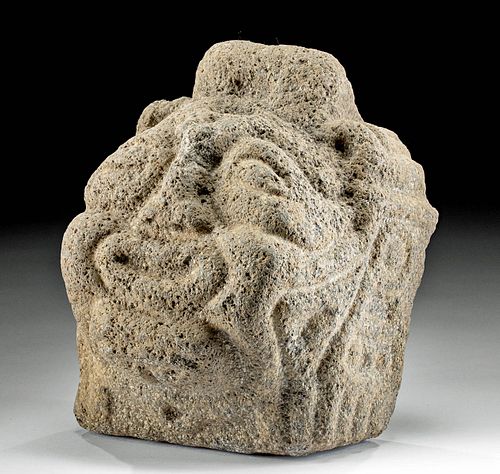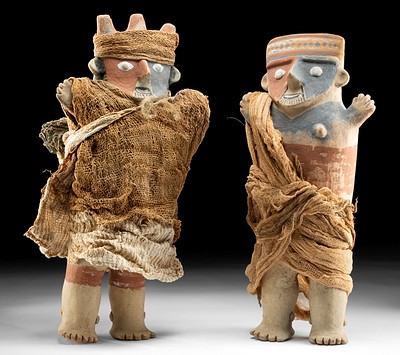Large Maya Stone Head Fragment w/ Face of Wind Deity
Lot 90b
About Seller
Artemis Fine Arts
686 S Taylor Ave, Ste 106
Louisville, CO 80027
United States
Selling antiquities, ancient and ethnographic art online since 1993, Artemis Gallery specializes in Classical Antiquities (Egyptian, Greek, Roman, Near Eastern), Asian, Pre-Columbian, African / Tribal / Oceanographic art. Our extensive inventory includes pottery, stone, metal, wood, glass and textil...Read more
Categories
Estimate:
$2,600 - $3,900
Absentee vs Live bid
Two ways to bid:
- Leave a max absentee bid and the platform will bid on your behalf up to your maximum bid during the live auction.
- Bid live during the auction and your bids will be submitted real-time to the auctioneer.
Bid Increments
| Price | Bid Increment |
|---|---|
| $0 | $25 |
| $300 | $50 |
| $1,000 | $100 |
| $2,000 | $250 |
| $5,000 | $500 |
| $10,000 | $1,000 |
| $20,000 | $2,500 |
| $50,000 | $5,000 |
| $100,000 | $10,000 |
| $200,000 | $20,000 |
About Auction
By Artemis Fine Arts
May 19, 2022
Set Reminder
2022-05-19 10:00:00
2022-05-19 10:00:00
America/New_York
Bidsquare
Bidsquare : Fine Antiquities | Ethnographica | Fine Art
https://www.bidsquare.com/auctions/artemis-gallery/fine-antiquities-ethnographica-fine-art-9350
Featuring a very special collection of Fine Art from the Hollywood Hills, including Picasso & Rookwood ceramics! Also included are many fine examples of classical antiquities, ancient, and ethnographic art from cultures encompassing the globe. Artemis Fine Arts info@artemisfinearts.com
Featuring a very special collection of Fine Art from the Hollywood Hills, including Picasso & Rookwood ceramics! Also included are many fine examples of classical antiquities, ancient, and ethnographic art from cultures encompassing the globe. Artemis Fine Arts info@artemisfinearts.com
- Lot Description
Pre-Columbian, Southern Mexico to Guatemala, Maya, Late Classic Period, ca. 550 to 900 CE. A hand carved anthropomorphic stone and of the Maya wind deity, Ik' K'uh, comprised of exaggerated facial features to emphasize his aspects. The piece is a head fragment from a larger statue, the flat sides are etched with large ear spools and ornaments, and atop the brow is a headdress. The visage is very jowly- a thick chin engraved with a T shape, under puckered lips and dimpled, fleshy cheeks under almond shaped eyes set next to a broad nose. The "T" is an important indicator of the deity, for this is the Maya symbol for wind or breath- and this visage looks like the cheeks are full of air to expel as a wind gust. Size: 9" L x 9" W x 12" H (22.9 cm x 22.9 cm x 30.5 cm)
The "T" is the symbol for the Mayan word "ik" meaning both wind and breath, but also had other more ambiguous meanings. Ik' K'uh is the wind and music deity that embodied the breath or spirit, which sustains the gods and invigorates their spiritual force. Breath and breathing marked the difference between life and death. Despite being a destructive force of nature, wind was also life affirming aspect. Wind instruments were important part of ritual use in Maya culture, drawing a connection between human breath, the energy force, creating sound, or giving life to an otherwise intimate object. Ik' K'uh was likely the predecessor to Ehecatl, the wind deity of the Aztecs. Ehecatl - a form of Quetzalcoatl - "Feathered Serpent" in the Nahuatl language - is the Pre-Columbian deity revered as the lord of air and sky. The earliest representations of Quetzalcoatl adorn the Temple of Quetzalcoatl in Teotihuacan, Mexico (ca. 3rd century CE) where numerous stone heads of the divine plumed snake embellish the steps of this Pre-Classic pyramid. The Aztecs believed Ehecatl was an aspect of Quetzalcoatl, and Ehecatl-Quetzalcoatl was associated with wind and creation.
Provenance: private Hidden Valley Lake, California, USA collection; ex-San Diego, California, USA collection, from the 1960s
All items legal to buy/sell under U.S. Statute covering cultural patrimony Code 2600, CHAPTER 14, and are guaranteed to be as described or your money back.
A Certificate of Authenticity will accompany all winning bids.
PLEASE NOTE: Due to recent increases of shipments being seized by Australian & German customs (even for items with pre-UNESCO provenance), we will no longer ship most antiquities and ancient Chinese art to Australia & Germany. For categories of items that are acceptable to ship to Australia or Germany, please contact us directly or work with your local customs brokerage firm.
Display stands not described as included/custom in the item description are for photography purposes only and will not be included with the item upon shipping.
#170518Fragment of a larger piece as shown. Loss and abrasion to nose. Softening to details, but visage is discernable. Chips and nicks throughout. Naturally porous surface with light mineral and earthen deposits. Overall excellent condition.Condition
- Shipping Info
-
All shipping is handled in-house for your convenience. Your invoice from Artemis Gallery will include shipping calculation instructions. If in doubt, please inquire BEFORE bidding for estimated shipping costs for individual items.
-
- Buyer's Premium



 EUR
EUR CAD
CAD AUD
AUD GBP
GBP MXN
MXN HKD
HKD CNY
CNY MYR
MYR SEK
SEK SGD
SGD CHF
CHF THB
THB














